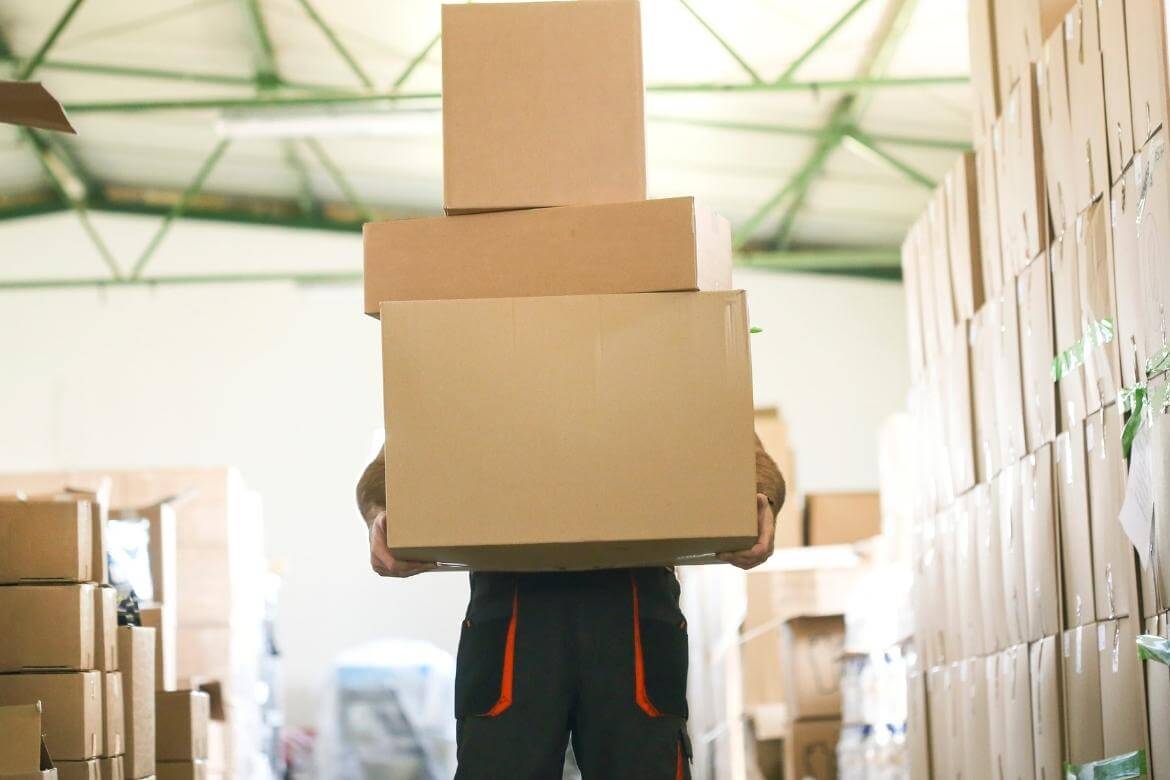27th September, 2023
The Importance Of Safe Manual Handling Techniques
Manual handling might not seem high risk, but it is actually one of the most common causes of workplace injuries. The importance of safe manual handling techniques can therefore mean the difference between a productive day at work or being off work with a bad back!

When you move, carry, lift, push or pull something, you are manual handling. If you carry a book, a box, a tool, or materials, you are manual handling.
Sometimes the item might be so light you can move it without much effort. Other times, it might be more tricky, for example, due to its weight or size.
Manual handling is an everyday task in most workplaces, whether you are filing paperwork in the office, stacking shelves in a shop, or bricklaying on site. Goods and materials, tools and equipment, all have to be moved, lifted and carried throughout the day.
“manual handling operations” means any transporting or supporting of a load (including the lifting, putting down, pushing, pulling, carrying or moving thereof) by hand or by bodily force.
Manual handling is risky
If we carry things all the time, then what's the problem? Why does manual handling have a set of health and safety regulations?
We lift and carry things at home, and we do it at work. It's normal.
Well, it is normal to carry things, but it's also risky. Because when manual handling goes wrong, people get hurt.
And it happens more often than you might think.
In fact, manual handling is one of the leading causes of musculoskeletal disorders (MSDs). These are disorders affecting muscles, joints and tendons in all parts of the body. A massive 6.6 million working days were lost due to MSDs in the UK in 17/18 according to HSE statistics.
Work-related musculoskeletal disorders account for 24% of all working days lost due to work-related ill health.
Manual handling might not seem high risk, but it is actually one of the most common causes of workplace injuries. Manual handling injuries are rarely fatal, but the harm can be long-term and painful.

You might think you only need to worry about manual handling if you are carrying heavy or large items. But it's not always what you carry - it's also how you carry it.
While work involving heavy manual labour such as construction work is higher risk, manual handling injuries happen to workers in all industries.
The first rule of manual handling is to eliminate manual handling. Because there is no safer way to handle something, than not to handle it at all!
It's not always possible, but if you can eliminate manual handling, you should. Elimination is the most effective control measure. This might be possible by having materials delivered to their place of use or installing equipment like conveyor belts.
But it's not always possible to eliminate manual handling and that's when safe manual handling techniques become important.
Safe manual handling is important to protect you from the pain and suffering that come with musculoskeletal disorders (MSDs).
Unsafe manual handling techniques increase the risk of injuries
Awkward postures, poor lifting techniques, and failing to route plan will all increase the risk of injury during manual handling tasks.
If you are putting too much strain on your back, or not lifting with a stable body, you are more likely to pull a muscle or slip a disc.
Your manual handling technique can mean the difference between a productive day at work or being off work with a bad back!

Legally, employers have a responsibility to ensure that steps are taken to reduce the risks from manual handling as low as reasonably practicable.
- ii. take appropriate steps to reduce the risk of injury to those employees arising out of their undertaking any such manual handling operations to the lowest level reasonably practicable
Safe manual handling techniques tend to focus on the initial lift, and it is important to get this stage of the process right. Bent legs, straight back, load close to the body, avoiding strain on the muscles of the back.
However, the correct manual handling technique should not stop with the lift. It is important to also consider what you are carrying, and where you are carrying it.
For example, the heaviest side of the load should be closest to your body to minimise strain when carrying, and you should grip the load with your palms, rather than your fingers.
Safe manual handling techniques are important because the right technique can significantly reduce the risk of injury.
Find out more about how to lift safely in our blog post how to correct your manual handling technique.
That's not to say that the right technique alone means that any handling challenge can be taken without health risks, work is not a weightlifting competition!
Manual handling training and knowing how to lift is a good place to start when practising safe manual handling. But, no matter how good your technique is, if you try to lift a load that is too heavy for your capabilities, you are at risk of injury.
Good manual handling techniques reduce the risks
I'm not going to say that a good manual handling technique eliminates all of the risks associated with manual handling. It doesn't.
Even with perfect manual handling technique, if you try to:
- Lift something too heavy for you
- Lift something hot
- Lift something sharp
- Carry something through a messy area
You will probably get injured. Those injuries will have nothing to do with your manual handling technique. It will be because the load burnt you, cut you, or you tripped. Or you strained yourself because the load was just too heavy.

When you are manual handling, there are more things than your technique to consider. You need to assess the load, the individual, the task and the environment (LITE).
Manual handling technique mostly focuses on the individual, and how they lift and carry to reduce the risk. And that's great, because it's the person who you are trying to protect, but it's still just one of the four areas of manual handling.
But once you have assessed the load, the individual, the task and the environment, and decided that manual handling is a safe option, then using good manual handling techniques will reduce the risk of injury because it:
- Creates a stable position
- Protects your back
- Uses your strong leg muscles to lift
- Makes the load easier to carry
It's not always possible to eliminate manual handling, and often it will be necessary to lift and carry things at work. In this case, and especially if there is a risk of injury, it is important to complete a manual handling risk assessment.
Once you have considered the hazards and specifics of your manual handling task, you can decide if extra safety measures are needed. Like mechanical aids, or a team lift, and training your team in safe manual handling techniques.
Don't wait for an injury to occur before taking action, learn the correct lifting and carrying techniques, and understand the risks and precautions needed when handling loads.
- Carry out a manual handling assessment
- Use mechanical aids where possible
- Consider team lifts
- Know the weight and any hazards associated with the load
- Make sure it is safe to manual handle the load
- Make sure any route is clear
- Use the correct manual handling lifting technique
If your work involves regular manual handling, you should get trained in safe manual handling techniques as part of your employment.
Raise awareness with our free manual handling toolbox talk, and make sure your manual handling activities are assessed with our manual handling risk assessment template.
This article was written by Emma at HASpod. Emma has over 10 years experience in health and safety and BSc (Hons) Construction Management. She is NEBOSH qualified and Tech IOSH.
Can you handle this?
Take our manual handling elearning course and get your certificate today.
Course InfoRecent posts like this...

Manual Handling? Think LITE!
Manual handling is the leading cause of musculoskeletal disorders at work. To avoid pulled muscles and painful joints, it's important to know how much you can safely lift, and use good handling techniques. In this blog post, we learn how to think LITE.
Read Post
13 Types Of Manual Handling Injuries And The Hazards That Cause Them
It might surprise you that manual handling is responsible for over 30% of workplace injuries. For something so simple, why so many accidents? Well, it's likely to be because we don't expect anything to go wrong - we lift things all the time.
Read Post
The Importance Of Safe Manual Handling Techniques
Manual handling might not seem high risk, but it is actually one of the most common causes of workplace injuries. The importance of safe manual handling techniques can therefore mean the difference between a productive day at work or being off work with a bad back!
Read Post